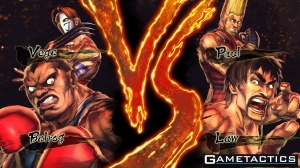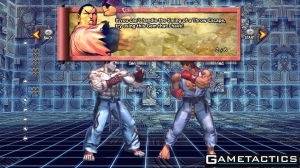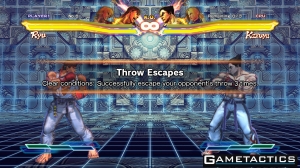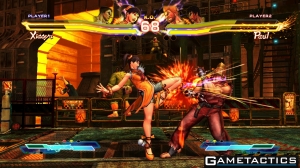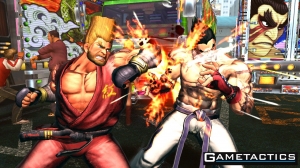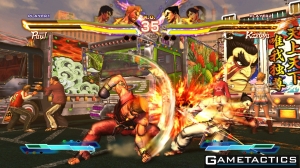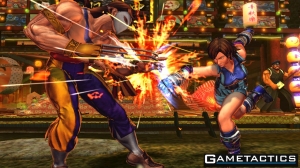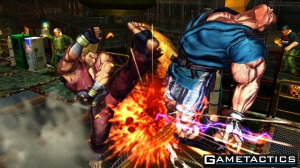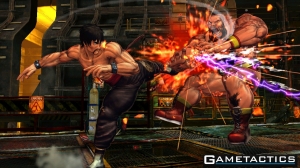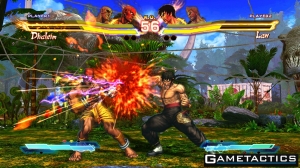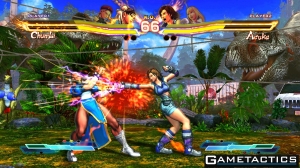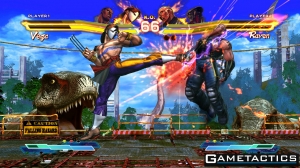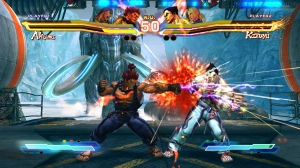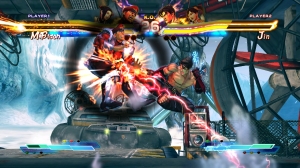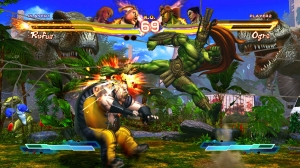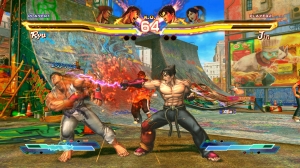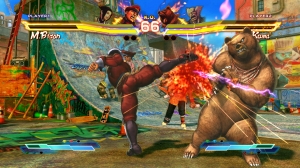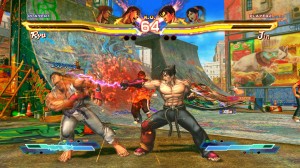 In 1991 Capcom’s Street Fighter II was released in arcades. With Subsequent upgrades and an addition of 4 new characters in 1993 (Super Street Fighter II), Street Fighter II was a large reason that fighting games became very popular in the 90s. The popularity of fighting games gave way to an influx of fighting games being made in the early to mid 90s, one of which was the Namco made Tekken.
In 1991 Capcom’s Street Fighter II was released in arcades. With Subsequent upgrades and an addition of 4 new characters in 1993 (Super Street Fighter II), Street Fighter II was a large reason that fighting games became very popular in the 90s. The popularity of fighting games gave way to an influx of fighting games being made in the early to mid 90s, one of which was the Namco made Tekken.
Released in 1994 in arcades, Tekken was both an example of Playstation technology and one of the earliest 3D fighting games, with 3D characters models fighting on a 3D plane. With the popularity of fighting games, especially among the core fighting community, long time fans have wondered about dream match ups between different fighting games that weren’t owned by the same company. So it came to be, in 2010, a partnership was announced between Capcom and Namco which would spawn 2 games that would be made pitting Tekken characters against Street Fighter characters. The first, would be released by Capcom, and titled Street Fighter X (cross) Tekken.
Street Fighter X Tekken is loosely related to the long line of VS. titles that Capcom has put out over the years. The story of that game is that a meteor crashes down in Antarctica and it turns out to be some weird box thing named Pandora that somehow is fueled or powered by conflict. The power within this box is sought out by many fighters over the world, but there’s also 2 major organizations looking to acquire this box: Shadaloo (the main bad guy/terrorist group from Street Fighter), and the Mishima Zaibatsu (Tekken’s more well-rounded business group version of Shadaloo). So you have 2 big organizations plus other fighters, all looking to get this box, and the power it holds. A simple enough premise.
Looks and gameplay wise, SFxT isn’t really anything you haven’t seen before. It’s art style is heavily influenced by Street Fighter IV. It’s gameplay is a weird amalgamation of Street Fighter and Tekken controls. And if you’ve played Tatsunoko vs Capcom, or Marvel vs Capcom, you know somewhat of what to expect from the tag team aspect of the game. Right from the beginning, the menu of the game is very similar to SF4. Arcade mode, Versus mode, challenges and training are all here. There’s a tutorial mode to teach you the new gameplay aspects of this game, as well as the basics for those whom have never played any type of fighting game before, all 4 of them. It gives you a nice feel for what this game is going to offer you.
Arcade Mode is your standard mode, you’ll get a little story introduction at the beginning, do a lot of fights, and then you get to the boss. You’ll find that the opening and ending cinematic don’t really change much from character to character depending on the team you pick. A team of fighters that may not work well together may have a very generic opening, while a team of fighters that’s meant to be together, for example Poison and Hugo or Ryu and Ken, will have a specific cinematic when teaming up in Arcade Mode. Versus mode is where you can play a casual match against the CPU or a 2nd player. Challenges mode is the same as in previous Capcom games, if you’ve played any of them. It’s the best way to learn a fighters special moves and a few combos for that fighter. Training mode is exactly what it sounds like, you can try out techniques and test out the timing and spacing for certain moves and combos here.
Some big additions to the game are Super Charge moves, launchers, Pandora Mode, and gems. Super Charge Moves are specific moves in each character’s moveset that can be charged to different degrees. It can be a regular special move, or charged a moment for an EX mode, or charged all the way to perform the character’s Super Arts Move, without the cost of any super meter, which is called the Cross Gauge in this game.
Launchers are moves which simultaneously launches your opponent into the air, and tags your partner in. This move can be done at the end of a Boost Combo, or on its own, giving your 2nd character/partner a chance to continue the beatdown with some kind of air juggle. This isn’t the only way to tag in your partner, as a simple press of the medium punch + medium kick will tag your partner in, even in a combo. The launcher is just a flashier and more damaging way, of tagging in. And to explain real quick, a Boost Combo is a combo where you go from light, or medium attack, to heavy attack. It can be done with all 3 attacks, or just 2 of them, but you have to end in a double press of the heavy attack to get the launcher. This is called a Cross Rush.
Pandora Mode is a weird little addition that can only be activated when one of your characters is at 25% life, or less. This will sacrifice your current character, leaving you with your 2nd character, who will be powered up and stronger than before. The catch is, you only have a limited time to actually win the round in this mode, because once Pandora Mode runs out, your character dies. It’s a very interesting addition to the gameplay, and something that can probably be fit into some strategies well if used right.
Finally, the main addition to the gameplay, gems. Gems are basically modifiers that you can customize to your character(s), based on what you feel would help the most. There are 2 types of gems, Assist Gems, which affect the team, and Boost Gems, which affect the individual character. Assist Gems will be active through the whole fight, but Boost Gems are only active for a limited time. Boost Gems need some type of “on switch” to be activated. Some of these are, hitting a special move once, or a few times in a row, doing a crouching attack, or a throw, or getting hit by some specific attack. There are 5 categories of Boost Gems; attack, defense, speed, vitality, cross gauge. The gems in that category will give some type of boosting effect to that part of your character, whether it’s more speed, regenerating life, or more damage output. Gems are the big game changers in this game, and can be the deciding factor in many fights.
The overall gameplay for SFxT is very pick up and play, but with a lot of depth. A little trip to the training mode will show you that doing a lot of moves, whether it’s a Street Fighter or Tekken character, are pretty easy. Even big double team Super Arts moves, which cost your whole super meter/cross gauge, are simply done with a quarter-circle forward motion, and hitting medium punch + medium kick. But the depth of the game, where you take into account the speed of moves, the gem modifiers, and the tag moves, make this game a very hard one to master.
Online mode is pretty standard here. The XBox Live menu gives you 5 options, Ranked Match, Endless Battle, Scramble Battle, Briefing Room, and Partner Settings. Let me start with Partner Settings, because this affects a few of the other modes. Partner Settings lets you invite an online friend to partner up with you. Sadly, you cannot play local multiplayer, so you can only team up with online friends. After teaming up with a friend, you can practice your double team moves or whatever in the Briefing Room, which is really just online training mode, which cannot be accessed unless you’ve formed a team with an online friend. You can also enter ranked, endless, or scramble battle with your partner, and test out your skills against other players/teams. You don’t need a partner to play any of the other battle modes. And if you’re in endless or scramble battle with at least 2 other people, you can choose to team up with one of them to battle the other, single, player. Scramble Mode, is a play mode where you have the 4 characters on screen at the same time. It’s a very fun, and different mode.
A big downside to online play is that there’s a major sound glitch. I can’t explain it. Just some sounds will play, some won’t, and it sounds really odd. It’s not a deal breaker, and it doesn’t affect the gameplay, but it can definitely disrupt your concentration. The actual gameplay is pretty smooth, and only affected by the typical internet connection stuff. I encountered bad lag only a few times, to the point where it seemed characters were teleporting because it was so slow and tried to catch up. But this happened less often than not, as the majority of my online battles had very little, if any, noticeable lag.
Overall, SFxT is a very awesome game. The gameplay is quick without being insanely quick, and the integration of Tekken moves while still keeping true to the Street Fighter controls was pretty well done. If you have the patience and will to practice enough, the deeper levels of the game, like the combos, and the air juggling and such, added with the online play and competition, will keep you playing this for a long time, or at least until the next great fighting game is released.
Gameplay
Graphics
Sound
Overall

